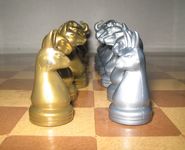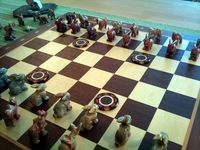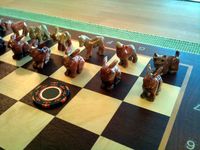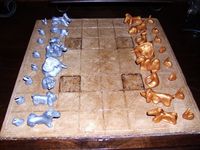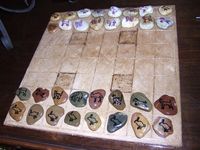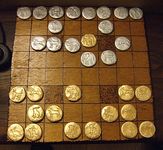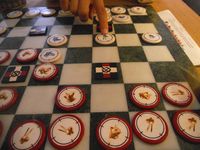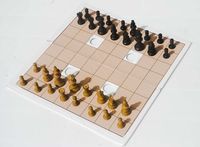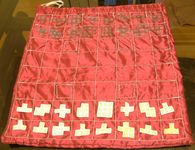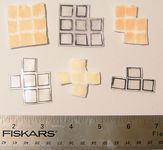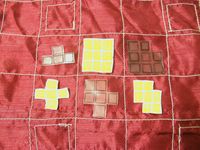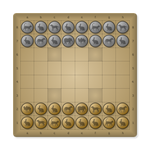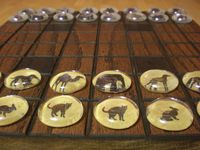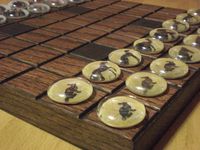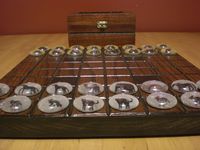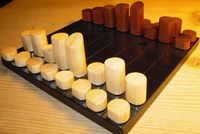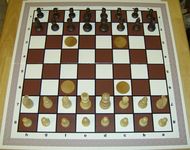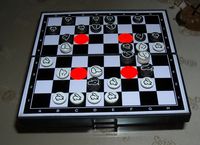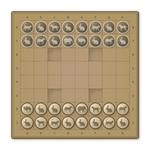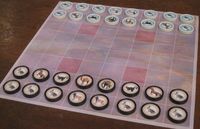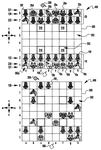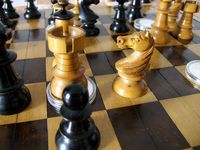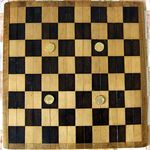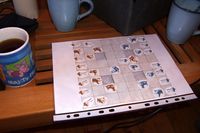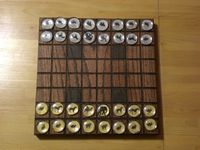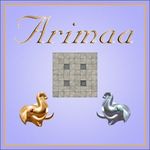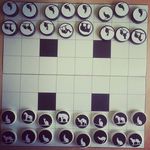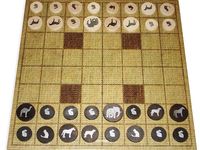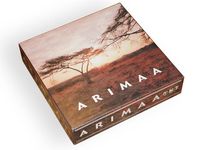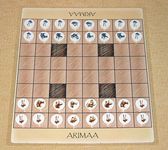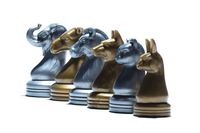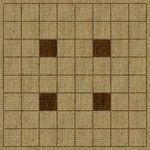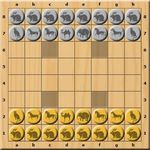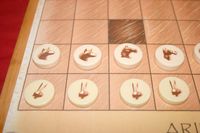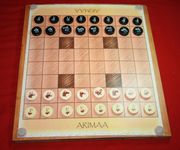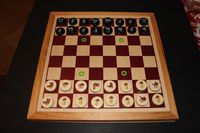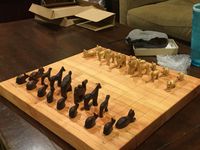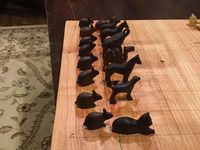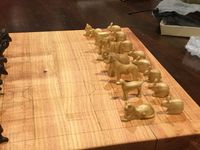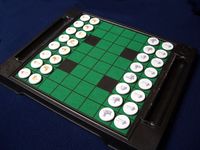

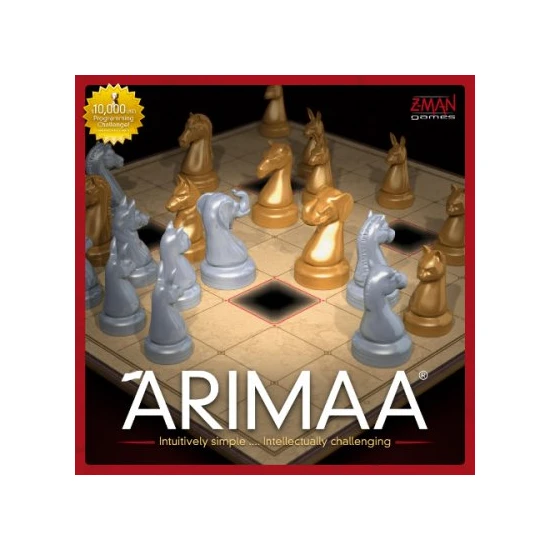
|
|
|
|
2
60'
12
No necessary in-game text
|
Arimaa

In a bygone age in the Far East, lost in the mists of time, was a game that enthralled one and all ... Arimaa, an ancient, mythical sport played by teams of sumo wrestlers. Unlike regular sumo which is an individual sport, Arimaa is played between two teams with 16 sumo wrestlers each. There are six different weight classes of wrestlers. The wrestlers in the heaviest class are called elephants, weighing in around 230 Kg (500 pounds). The next heaviest class is camels, followed by horses, dogs, cats and finally the lighted wrestlers are called rabbits. Although they are called rabbits, these wrestlers still weigh about 115 Kg (250 pounds). The wrestlers wear animal shaped helmets matching their weight class. For example the rabbit class wrestlers wear rabbit shaped helmets. One team wears helmets of gold while the other wears helmets of silver. Each team has only one elephant and camel class wrestlers. There are two wrestlers on a team for the horse, dog and cat classes. The rabbit class has eight wrestlers per team. Arimaa is played on a square shaped clay field that is about 8 meters by 8 meters. The field is divided into an 8x8 grid so there is a total of 64 squares. Each square is just big enough to hold one wrestler. Although most of the field is dry clay four of the squares are filled with wet, black mud to make them slippery and hard to stand on. These muddy squares are located at c3, c6, f3 and f6 and are referred to as trap squares. You'll find out soon enough what they are used for. The game begins with the gold team stepping onto the field and occupying the 16 squares of the first two rows on one side of the field. There are no predefined positions for the wrestlers, so each wrestler may choose what square to stand on as long as it's within the first two rows. If there are any disputes between wrestlers of the same team, the captain of the team (the elephant class wrestler) will settle the dispute. Once the gold team has taken their position, the silver team steps onto the field occupying the first 16 squares on the opposite side of the field. Each silver team wrestler will also choose what square to stand on as there are no predefined starting position for any wrestler. The object of the game is for one of the rabbit class wrestlers to cross the field and reach the first row of the opponents side. Although this may sound easy, it is quite difficult for a rabbit class wrestler to reach the other side. This is because the heavier wrestlers can bully the lighter ones of the opposing team by pushing them, pulling them or holding on to them so they are frozen and can't move. After both teams have entered the field the wrestlers on the gold team can perform four actions. An action consists of a wrestler stepping from the current square to an adjacent unoccupied square. The step must be to an orthogonally adjacent square that is north, south, east or west of the current square. One action cannot be used to move to a diagonally adjacent square. It can be achieved by stepping through an unoccupied interconnecting square and uses up two actions. If a wrestler wants to push or pull a lighter wrestler from the other team, it requires two actions. For example to perform a push action the heavier wrestler must push the lighter wrestler to an unoccupied square that is orthogonally adjacent to the lighter wrestler and move into the pushed wrestlers square. To perform a pull action the heavier wrestler moves to an unoccupied orthogonally adjacent square while dragging the opposing teams lighter wrestler to the square it leaves. Wrestlers of the same weight class cannot push or pull each other and a wrestler cannot pull while it is pushing at the same time. The team can distribute the four actions any way it wants. All four actions can be taken by one wrestler or various different wrestlers can take one or more actions. The team does not have to take all four actions as long as it takes at least one action to change the state of the game. Unused actions are lost and do not carry over to future moves. Once the gold team has made the move the silver team can proceed and take up to four actions. Any wrestler that is orthogonally adjacent to a heavier wrestler from the opposing team will be held in place by the heavier wrestler and cannot move unless one of its teammates comes orthogonally adjacent to it. This helps the lighter wrestler break free of the opposing wrestlers grip and become free to move. Since sumo wrestlers have small feet and heavy bodies they have to be very careful if they step into any of the four muddy trap squares. A wrestler that steps into a trap square will slip and fall and become dirty. A muddy wrestler cannot continue playing and must come off the field. But if a teammate is orthogonally adjacent to the trap square the wrestler can get support from the teammate and step into the trap square without fear of falling. In a typical game the teammates will coordinate their actions so the the heavy wrestlers will push or pull the opposing teams lighter wrestlers out of the way or into the trap squares and clear a path for one of their rabbit class wrestlers to reach the other end of the field. This is referred to as winning by goal. If a team is able to eliminate all the rabbit class wrestlers of the opposing team by making them fall in the trap squares and having to leave the field the team automatically wins the game. This is referred to as winning by elimination. If a team is able to block up and freeze all the opposing wrestlers such that the opposing team cannot make a move without breaking the rules, the team immediately wins the game. This is referred to as winning by immobilization. Now Z-Man Games recaptures the magic of this ancient pastime in an intense and dramatic strategy board game. Designed by Omar and Aamir Syed, Arimaa is intended to be difficult for computers to play well, while still being fun and easy for humans (google "Arimaa - A New Game Designed to be Difficult for Computers" Journal of the International Computer Games Association. June 2003). The average number of unique moves possible at each turn in Arimaa is over 15,000 compared to about 30 for Chess. Yet humans have no difficulty finding the good moves. Computers struggle to see beyond 4 turns and aren't able to use opening books or end game tables. There is a reward of $10,000 for the first person or company who can build a computer program that can defeat selected top human Arimaa players prior to 2020. This challenge has been attempted every year since 2004 and the humans have successfully defended it each year. In the 2009 match, the human world champion Jean Daligault defeated the computer by giving the equivalent of a rook handicap in chess. Arimaa was selected by GAMES magazine as the best abstract strategy game for 2011. Scientific American MIND called the game "creative and engaging" while one of the Mensa judge reviewed the game as "most likely to still be around in 1000 years". More information about Arimaa is available at the http://www.arimaa.com/ website where visitors can also play the game online with others. About 5000 games are played each month. http://arimaa.com/arimaa/gameroom/recentgames.cgi Kickstarter for handmade wooden sets expires 2012-05-31: http://www.boardgamegeek.com/thread/792401/wooden-arimaa-sets-on-kickstarter
| Mechanics: | Action Point Allowance System |
| Categories: | Racing Fighting Animals Strategy |
| Alternative names: | |
| In 6 wishlists In 1 collection This was seen 8596 times | |
In a bygone age in the Far East, lost in the mists of time, was a game that enthralled one and all ... Arimaa, an ancient, mythical sport played by teams of sumo wrestlers. Unlike regular sumo which is an individual sport, Arimaa is played between two teams with 16 sumo wrestlers each. There are six different weight classes of wrestlers. The wrestlers in the heaviest class are called elephants, weighing in around 230 Kg (500 pounds). The next heaviest class is camels, followed by horses, dogs, cats and finally the lighted wrestlers are called rabbits. Although they are called rabbits, these wrestlers still weigh about 115 Kg (250 pounds). The wrestlers wear animal shaped helmets matching their weight class. For example the rabbit class wrestlers wear rabbit shaped helmets. One team wears helmets of gold while the other wears helmets of silver. Each team has only one elephant and camel class wrestlers. There are two wrestlers on a team for the horse, dog and cat classes. The rabbit class has eight wrestlers per team. Arimaa is played on a square shaped clay field that is about 8 meters by 8 meters. The field is divided into an 8x8 grid so there is a total of 64 squares. Each square is just big enough to hold one wrestler. Although most of the field is dry clay four of the squares are filled with wet, black mud to make them slippery and hard to stand on. These muddy squares are located at c3, c6, f3 and f6 and are referred to as trap squares. You'll find out soon enough what they are used for. The game begins with the gold team stepping onto the field and occupying the 16 squares of the first two rows on one side of the field. There are no predefined positions for the wrestlers, so each wrestler may choose what square to stand on as long as it's within the first two rows. If there are any disputes between wrestlers of the same team, the captain of the team (the elephant class wrestler) will settle the dispute. Once the gold team has taken their position, the silver team steps onto the field occupying the first 16 squares on the opposite side of the field. Each silver team wrestler will also choose what square to stand on as there are no predefined starting position for any wrestler. The object of the game is for one of the rabbit class wrestlers to cross the field and reach the first row of the opponents side. Although this may sound easy, it is quite difficult for a rabbit class wrestler to reach the other side. This is because the heavier wrestlers can bully the lighter ones of the opposing team by pushing them, pulling them or holding on to them so they are frozen and can't move. After both teams have entered the field the wrestlers on the gold team can perform four actions. An action consists of a wrestler stepping from the current square to an adjacent unoccupied square. The step must be to an orthogonally adjacent square that is north, south, east or west of the current square. One action cannot be used to move to a diagonally adjacent square. It can be achieved by stepping through an unoccupied interconnecting square and uses up two actions. If a wrestler wants to push or pull a lighter wrestler from the other team, it requires two actions. For example to perform a push action the heavier wrestler must push the lighter wrestler to an unoccupied square that is orthogonally adjacent to the lighter wrestler and move into the pushed wrestlers square. To perform a pull action the heavier wrestler moves to an unoccupied orthogonally adjacent square while dragging the opposing teams lighter wrestler to the square it leaves. Wrestlers of the same weight class cannot push or pull each other and a wrestler cannot pull while it is pushing at the same time. The team can distribute the four actions any way it wants. All four actions can be taken by one wrestler or various different wrestlers can take one or more actions. The team does not have to take all four actions as long as it takes at least one action to change the state of the game. Unused actions are lost and do not carry over to future moves. Once the gold team has made the move the silver team can proceed and take up to four actions. Any wrestler that is orthogonally adjacent to a heavier wrestler from the opposing team will be held in place by the heavier wrestler and cannot move unless one of its teammates comes orthogonally adjacent to it. This helps the lighter wrestler break free of the opposing wrestlers grip and become free to move. Since sumo wrestlers have small feet and heavy bodies they have to be very careful if they step into any of the four muddy trap squares. A wrestler that steps into a trap square will slip and fall and become dirty. A muddy wrestler cannot continue playing and must come off the field. But if a teammate is orthogonally adjacent to the trap square the wrestler can get support from the teammate and step into the trap square without fear of falling. In a typical game the teammates will coordinate their actions so the the heavy wrestlers will push or pull the opposing teams lighter wrestlers out of the way or into the trap squares and clear a path for one of their rabbit class wrestlers to reach the other end of the field. This is referred to as winning by goal. If a team is able to eliminate all the rabbit class wrestlers of the opposing team by making them fall in the trap squares and having to leave the field the team automatically wins the game. This is referred to as winning by elimination. If a team is able to block up and freeze all the opposing wrestlers such that the opposing team cannot make a move without breaking the rules, the team immediately wins the game. This is referred to as winning by immobilization. Now Z-Man Games recaptures the magic of this ancient pastime in an intense and dramatic strategy board game. Designed by Omar and Aamir Syed, Arimaa is intended to be difficult for computers to play well, while still being fun and easy for humans (google "Arimaa - A New Game Designed to be Difficult for Computers" Journal of the International Computer Games Association. June 2003). The average number of unique moves possible at each turn in Arimaa is over 15,000 compared to about 30 for Chess. Yet humans have no difficulty finding the good moves. Computers struggle to see beyond 4 turns and aren't able to use opening books or end game tables. There is a reward of $10,000 for the first person or company who can build a computer program that can defeat selected top human Arimaa players prior to 2020. This challenge has been attempted every year since 2004 and the humans have successfully defended it each year. In the 2009 match, the human world champion Jean Daligault defeated the computer by giving the equivalent of a rook handicap in chess. Arimaa was selected by GAMES magazine as the best abstract strategy game for 2011. Scientific American MIND called the game "creative and engaging" while one of the Mensa judge reviewed the game as "most likely to still be around in 1000 years". More information about Arimaa is available at the http://www.arimaa.com/ website where visitors can also play the game online with others. About 5000 games are played each month. http://arimaa.com/arimaa/gameroom/recentgames.cgi Kickstarter for handmade wooden sets expires 2012-05-31: http://www.boardgamegeek.com/thread/792401/wooden-arimaa-sets-on-kickstarter
| Mechanics: | Action Point Allowance System |
| Categories: | Racing Fighting Animals Strategy |
| Alternative names: | |
| In 6 wishlists In 1 collection This was seen 8596 times | |




